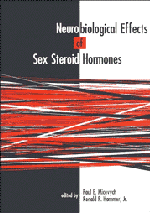Book contents
- Frontmatter
- Contents
- List of contributors
- Dedication
- Preface
- Acknowledgments
- Part I Sex steroid–responsive circuits regulating male and female reproductive behaviors
- Part II Sex steroid interactions with specific neurochemical circuits
- Part III Cellular and molecular mechanisms regulated by sex steroids
- 12 Neurosteroids and neuroactive steroids
- 13 Estrogen synthesis and secretion by the songbird brain
- 14 Neurobiological regulation of hormonal response by progestin and estrogen receptors
- 15 Molecular actions of steroid hormones and their possible relations to reproductive behaviors
- 16 Effects of sex steroids on the central nervous system detected by the study of Fos protein expression
- 17 Developmental interactions of estrogens with neurotrophins and their receptors
- 18 Sex steroid influences on cell–cell interactions in the magnocellular hypothalamoneurohypophyseal system
- Index
15 - Molecular actions of steroid hormones and their possible relations to reproductive behaviors
Published online by Cambridge University Press: 15 October 2009
- Frontmatter
- Contents
- List of contributors
- Dedication
- Preface
- Acknowledgments
- Part I Sex steroid–responsive circuits regulating male and female reproductive behaviors
- Part II Sex steroid interactions with specific neurochemical circuits
- Part III Cellular and molecular mechanisms regulated by sex steroids
- 12 Neurosteroids and neuroactive steroids
- 13 Estrogen synthesis and secretion by the songbird brain
- 14 Neurobiological regulation of hormonal response by progestin and estrogen receptors
- 15 Molecular actions of steroid hormones and their possible relations to reproductive behaviors
- 16 Effects of sex steroids on the central nervous system detected by the study of Fos protein expression
- 17 Developmental interactions of estrogens with neurotrophins and their receptors
- 18 Sex steroid influences on cell–cell interactions in the magnocellular hypothalamoneurohypophyseal system
- Index
Summary
A new generation of neurobiological work beyond the classical demonstrations of hormone–behavior relations by Beach, Young, and their colleagues has provided the launching platform for serious molecular analyses of some of the neuroendocrine mechanisms involved. Following the determination of cellular targets for estradiol in the brain (Pfaff 1968), a circuit for estrogen-dependent lordosis behavior was elucidated (Pfaff 1980). Principles of steroid hormone/central nervous system/behavior mechanisms include the apparent universality among vertebrates of certain nuclear binding features; the conservation of many endocrine and biochemical reactions from simpler non-neural tissues; the modular construction of the neural circuit for reproductive behavior; and the economic use of neural information within the circuit on both the sensory and motor sides (Pfaff et al. 1994). The explosion of molecular techniques and knowledge surrounding nuclear hormone receptors enables us to analyze brain mechanisms further for steroid-influenced behaviors using mRNA hybridization, genomic structure, protein-DNA binding, in vitro transcription, antisense DNA, and neurotrophic viral vector technologies.
Receptor structure
Steroid hormones influence mammalian tissues by promoting cell development and differentiation as well as acute cellular functions. In target tissues, steroids act by entering the cell and binding to specific receptor proteins. These receptors, which belong to a class of ligand-inducible transcription factors, regulate transcription by interacting with short cis-acting DNA elements – termed hormone response elements (HRE) – in the promoter regions of specific genes (Carson-Jurica et al. 1990; Yamamoto 1985).
- Type
- Chapter
- Information
- Neurobiological Effects of Sex Steroid Hormones , pp. 350 - 362Publisher: Cambridge University PressPrint publication year: 1995
- 1
- Cited by



